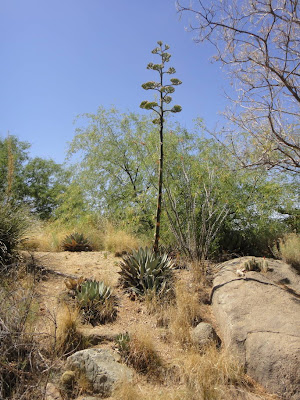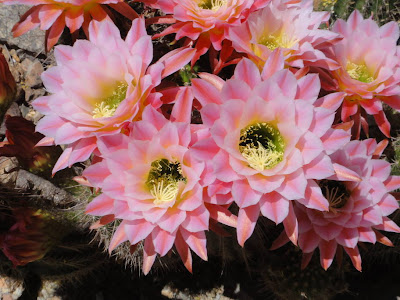The terrain while driving down to Arizona started to change color, more green was being seen. The green here was due to the cactus as opposed to forest, but still a pretty sight nonetheless. We surmised the reason for the increase in vegetation was on account of an increase in humidity. "Welcome to Tucson
 |
| View from our campsite |
Dog Park or a Park Named After Our Dog - Just NE of Tucson was Catalina State Park, we knew by the name (and the positive reviews didn't hurt either), that we had to stay there. What a pretty park with many hiking trails & amenities near by. One of the most significant differences between AZ & NM is the appearance of the Saguaro cactus (the tall kind with arms or what you would see if watching a Wylie coyote & roadrunner cartoon!).
 |
| Saguaro Cactus, they say by the time it starts to grow "arms" it is already 70 yrs old! |
I emailed my friend Charlene who used to live in Tucson and asked what she recommended us to do while in the area. One of the items she mentioned was the Desert Museum. We timed our arrival to the museum perfectly since a walking tour was about to commence. Our guide gave us a great overview on the desert plant life as well as animal life. He even gave us samples of cactus fruit, (tasted like a tart plum). We never expected to see such an array of colors in a desert, it was all in bloom...our timing couldn't have been better! At the end of our tour we were able to take part in a live animal discussion on rattlesnakes and gila monsters. We soon discovered our $2.99 Walmart snake bite kit was pretty much a waste of money since the only thing you should do if bitten by a rattlesnake is go directly to the hospital!
Another must see was the Davis-Monthan Air Force Base for it's Boneyard and the Pima Air & Space Museum next door (where you buy your tickets for the Boneyard tour). So many volunteers with gobs of history knowledge and experiences, one could spend a good couple of days just talking to all the great people working at the museum. All the planes in the Boneyard had their windows & canopies coated with a white latex spray to protect the instruments and keep the interior cooler.
 |
| Huey & Cobra Helicopters |
We were amazed to hear that there was a lifespan to the inhabitants of the Boneyard. Eventually the jaws of death machine is called in and literally chews them up into scrap. We were informed the Air Force Base actually makes a very healthy profit from selling what parts they are able to salvage to buyers world wide, literally millions are made!
 |
| SR-71 Blackbird |
 |
| BD-5J Jet, no it's not a toy! |
 |
| Local artists decided to tart up some old planes before they were "recycled" |
Living in a bubble - Biosphere 2
Another attraction was Biosphere 2, it was a study to see if humans could live in a contained environment (ie. a glass bubble like structure) for 2 years. In the early 1990's a group of scientists lived in the Biosphere for 2 years, although they successfully stayed for the 2 year period, studies showed all participants had a reduced body fat % (where do I sign up!!!), and that the focus on food generation, harvesting & processing occupied most of their time.
 |
| This is the ocean section in Biosphere 2 |
 |
| Happy Trails! |









